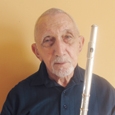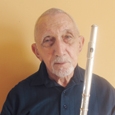In reading Craig Robert’s account in the December Flute Talk about his return to flute playing (“Back in the Flute Loop”), I was struck by how different his goal was from mine, yet how similar the difficulties were we encountered. Roberts had something of a solid foundation playing the flute in his youth. I was a sax player of advanced years wanting to expand my playing opportunities by becoming a doubler on the flute.
As a child growing up in Philadelphia in the 1940s, my romantic attachment was to the big bands that appeared regularly at the Earl Theater. Whether Benny Goodman, Kay Kaiser or a lesser name band was on the bill, I was there in awe of the sound and glamour. Eventually, I began clarinet and then saxophone lessons with one of the city’s premier teachers. Some modest success, in the form of winning first chair clarinet in my high school band, gave me the encouragement I needed to audition as a bandsman in the United States Marine Corps. I spent the next six years playing clarinet and saxophone in various Marine Corps post bands from Quantico, Virginia to San Francisco.
When the GI education bill was reintroduced as a benefit, I, like Roberts, decided to pursue a different career and left the service. I continued to enjoy playing with local bands while in college but eventually the pursuit of a career in journalism and higher education left little time and small opportunity to continue playing. The clarinet and tenor sax went into the closet.
In 1985 the chairman of the music department at our local university started a community band. I offered my services on saxophone (there were no auditions) and to avoid a humiliating embarrassment, I began woodshedding on the saxophone.
I also hoped that if I became proficient again, I might rejoin the big band scene. During the time that I had been away from playing, the role of the saxophone player had been redefined. Saxophone players now were expected to play the flute as well as the clarinet. If I wanted a chance to play in some of the local bands on these newer arrangements, I would have to become serious about playing the flute. I was in my mid-50s when I began practicing again, and six years later purchased a beginner model flute from a niece who no longer played. I soon graduated to a better instrument and then realized that I needed a teacher to help me become proficient on the flute.
My first teacher was the young wife of a university faculty member whom I knew from our community band connection. She was well-credentialed and skilled in her own right. However, she taught in a converted bedroom in her suburban home while her two young children were sometimes under foot. Her students were mostly beginners of junior high and high school age. While she knew me as a member of the band; she made no attempt to explore my reasons for taking flute lessons at my advanced age.
Nevertheless, her attempts were noble. I wrote copious notes about the fundamentals of tone production, lip formation, air direction and speed. She introduced me to De La Sonorite by Marcel Moyse and the 17 Big Daily Exercises by Taffanel & Gaubert. In retrospect we both might have been better served by Mary Karen Clardy’s Flute Fundamentals or Trevor Wye’s Practice Books.
The following year the flute professor at the local university graciously added me to his roster of students. He knew something of my background in music and understood why I was making the effort to learn to play the flute. Our first lessons were from Kalmus, Flute Studies, Volume 1. Over a period of five years I was introduced to the etudes by Andersen, Gariboldi, Koehler and Terschak from the Melodious and Progressive Studies (Edited by Robert Cavally). I also undertook on my own (prematurely, I might add) the Top Register Studies for Flute by Thomas J. Filas. Again in retrospect, I feel that while I progressed as a player during this period, there might have been too much collegiality in our teacher-student relationship especially with respect to tone production. Perhaps he may have thought that as a doubler, I did not need to achieve any lofty playing goals or maybe I would improve by the process of trying.
In 2005 my wife and I moved to a Kansas City, Missouri suburb to be closer to the arts and entertainment scene and more playing opportunities. By this time I had acquired a Powell Conservatory model and was more than casually interested in developing as a flute player. Within a year I contacted my present flute teacher. She is a teacher and free-lance musician with several degrees and probably accepted me as a student because of her admiration for a mutual friend’s musicianship. It was certainly not out of admiration for my flute playing. Our early relationship, one in which I attempted to impress her with my playing of etudes I was already familiar with, was somewhat rocky and tense. She was not at all pleased with my tone quality, and for good reason. She assigned me Moyse’s Tone Development through Interpretation and the 24 Melodic Studies plus the Melodious Etudes for Flute, edited by Larry Clark and Sean O’Laughlin. Later she introduced me to Andre Maquarre’s Daily Exercises.
Her greatest asset to me was that she was a careful listener. She must have gotten tired of constantly reminding me to “relax the throat, mouth, jaw and lips and move the air forward constantly and unimpeded.” If I stopped when playing a passage because the tone had deteriorated and then took another crack at it, she asked the obvious, “What did you do to make the sound better?” She encouraged me to listen to recordings of masters and contemporary artists. As she began to understand my goals in learning to play the flute, she allowed me a good deal of flexibility in what and how I prepared for a lesson. Trained in the old school, I regarded scales and arpeggios as key to successful development of sound and flexible technique. At the age of 82, I no longer take lessons regularly but still arrange for an occasional lesson because playing the flute is now a joy for me. Though I still play in a couple of big bands on occasion, I no longer seek the level of activity I once did.






